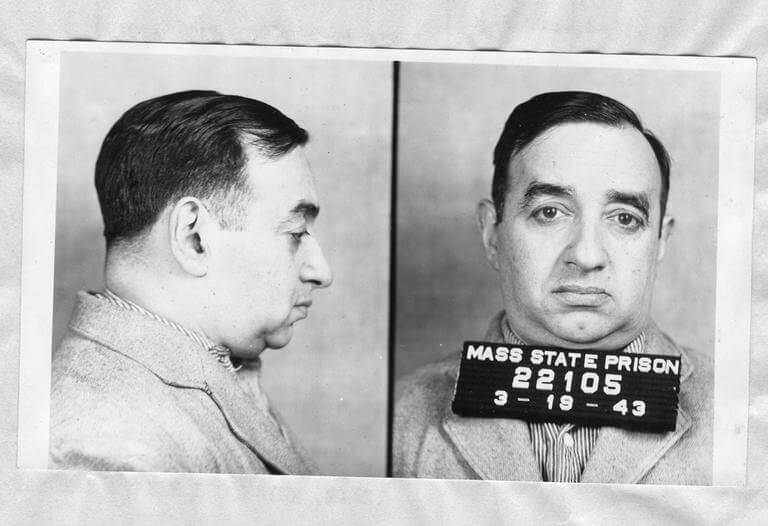Harry J. 'Doc' Sagansky
“Doc” Sagansky, the Jewish gambling boss who became the oldest organized crime figure to serve prison time, is one of the old West End’s more notorious residents. The money Sagansky made from illegal bookkeeping funded his business ventures and philanthropy: legitimate on the surface, corrupt at the source.
Harry J. “Doc” Sagansky was born to Jewish Lithuanian immigrants on January 6, 1898, and grew up in the old West End. Former residents recall that a young Sagansky was their newsboy, and in those early years he had also sold newspapers at the State House. Sagansky received his dentistry degree from Tufts University in 1918, and became a practicing dentist in Scollay Square (present-day City Hall Plaza), living in Brookline with his wife Molly at 168 Gardner Road. But he was also a gambler; in 1919, Sagansky was fined $3 for “gaming on the Lord’s Day,” fined $10 for the same charge in 1923, and in 1927 fined a total of $50 for registering bets and running a place for those bets. With money presumably from his gambling ventures, Sagansky invested in many businesses. After graduating from Tufts, he opened a liquor store in Boston, which was forced to close by Prohibition in 1920. He then invested in two Boston nightclubs, the Mayfair (in 1934) and Latin Quarter (in 1943), and entered into partnerships with Mickey Redstone, father of Sumner Redstone. Sagansky and Mickey Redstone opened a loan company in Massachusetts and a theater company in New York; Redstone was also principal stockholder for the Mayfair. Money from Sagansky supported Redstone’s first drive-in theater in Long Island, which opened in 1934.
“Doc” Sagansky was no ordinary investor, as he controlled Boston’s largest illegal bookmaking operation. Because of the shady, underground nature of his activities, Sagansky often went by aliases, including “Doc Jasper.” Sagansky was arrested, but released, for establishing and promoting a lottery in 1937, but he continued to operate an illegal gambling ring connected to organized crime. In 1943, Sagansky and twenty-two other people were arrested in a raid, which implicated the dentist as the mastermind of a $90 million gambling operation. On the charge of bribing an alderman from Malden to permit a game of Beano (the 1920s precursor to bingo), Sagansky served two-and-a-half years in prison. Sagansky’s trial led the Boston Licensing Board to review whether Club Mayfair should have its license revoked. The board’s chair, Mary Driscoll, asked why Mayfair’s counsel, Edwin Richardson, did not disclose that Redstone borrowed money from a Boston bank in addition to Sagansky’s $21,000 loan; Richardson admitted his mistake in giving an incomplete record. Driscoll said that the fact Mayfair’s capital did not come entirely from a corrupt, illegal source “throws a different light on the case.”
The more money that Sagansky made from illegal bookkeeping, the less he practiced dentistry. A 1950s Senate investigation by Senator Estes Kefauver (D-TN) found, from state officials’ testimony, that Sagansky was “one of the top 150 bookies in the nation,” per the Boston Globe, and that he netted more than $3 million into his bank account. A 1953 state investigation by Attorney General George Fingold found that Boston police officers sometimes even guarded Sagansky’s headquarters, demonstrating his political connections. Sagansky gave a $8,500 loan to former Mayor and congressional representative James Michael Curley; Curley’s life insurance policy, which named Sagansky as a beneficiary, was collateral for the loan (the life insurance policy was discovered in a police raid).
Sagansky’s criminal record blended with intermittent philanthropic acts, undoubtedly funded by his gambling organizations. In the 1950s, Sagansky gave Tufts Dental School one of the largest gifts the school had received in its history up to that point. In 1954, Sagansky was charged alongside Eugene Wermuth and Morris Weinstein of running an illegal, million-dollar horse betting ring from Wermuth’s apartment. Sagansky was named in almost every investigation of “bookies” in Boston for the next forty years, and in August 1981 was searched by state police at a Back Bay hotel. By that point, Doc had not practiced dentistry for forty-two years.
In January of 1988, when Doc Sagansky was 91 years old, he turned himself in to federal marshals after refusing to testify before a grand jury investigating organized crime. The grand jury had obtained evidence that at 89, Sagansky was still involved in an illegal gambling ring that financed organized crime. Released after ten months, Sagansky was the oldest organized crime figure to serve prison time. He died on January 28, 1997.
Article by Adam Tomasi
Source: American Journalism Review; Associated Press; Boston Globe online; Vanity Fair; The West Ender; wbur; Boston Globe ProQuest archive, “Decision Reserved by Licensing Board in Club Mayfair Case” (March 6, 1943), “Verdict Today on Sagansky and Carrigan” (February 17, 1943), “Sagansky, Once a Dentist, Also Known as Businessman” (January 13, 1943), “Sagansky’s Police Record” (January 13, 1943), “Sagansky re-emerges in bookie probe” (October 25, 1981), “‘Doc’ Sagansky Arrested in Brookline Bookie Raid” (March 11, 1954)








